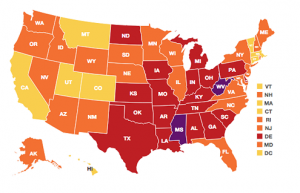Mississippi and West Virginia top the state rankings for adult obesity with Colorado again at the bottom, according to the new annual report on obesity that gives just a hint of positive news in another year of rising rates.
For cancer risk, the state of obesity is a major concern. Aside from not smoking, staying a healthy weight is the single biggest lifestyle factor related to cancer risk. AICR estimates that overweight and obesity increase risk of 8 cancer types.
The State of Obesity is the 11th annual report on obesity rates from the Trust for America’s Health and the Robert Wood Johnson Foundation. (The report was formerly called F as in Fat.) For each state, the report looks at obesity-related cancers as well as heart disease and other health disorders related to obesity. You can also see each state’s policies on issues related to obesity.
Overall, the news is not good: Every state in our country has over one in five people obese; in 43 states, the rates are one in four. Adult obesity rates increased in six states over the past year, and did not decrease in any. More than one in ten children become obese at ages 2 to 5. As of the last available data, 2011-2012, nearly one out of three children and teens are overweight or obese.
The report also found many disparities, with obesity rates highest in the South and among Blacks, Latinos and lower-income, less-educated Americans. A special report on disparities found that almost half of African Americans, 43 percent of Latinos, 33 percent of Whites and 11 percent of Asian Americans were obese.
Here’s the positive: After decades of rising obesity rates among adults, the rate of increase is beginning to slow, according to the report. And national childhood obesity rate has remained stable.
The report issues high-priority recommendations, such as focusing on healthy food financing and improving nutrition and activity in schools and child care settings.
You can see how your state ranks and its obesity-related policies on their interactive site.






